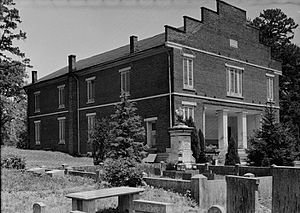Zion Presbyterian Church (Columbia, Tennessee) facts for kids
Quick facts for kids Zion Presbyterian Church |
|
|---|---|

Zion Presbyterian Church in 1936
|
|
| 35°35′56″N 87°8′42″W / 35.59889°N 87.14500°W | |
| Location | Maury County, Tennessee |
| Country | United States |
| Denomination | Presbyterian Church in America |
| History | |
| Status | Church |
| Architecture | |
| Functional status | Active |
| Style | Greek Revival |
| Completed | April 7, 1849 |
| Construction cost | US$7,000 |
| Specifications | |
| Materials | Brick |
The Zion Presbyterian Church is a very old and important building in Maury County, Tennessee. It was built between 1847 and 1849. The church is made of brick and designed in a style called Greek Revival. A famous person, President James K. Polk, once went to a school that the church ran. Because of its history, the church was added to the National Register of Historic Places on June 13, 1972. This means it's a special place worth protecting.
A Look Back in Time
Zion Presbyterian Church was started a long time ago, in the early 1800s. It was founded by families from South Carolina who had come from Scotland and Ireland. In 1807, these families got together and built their first church. They built it on a large piece of land, about 5,000 acres. This land was bought from the family of Nathanael Greene, a famous general from the American Revolutionary War. He had received the land as a gift for his service.
The first church building was replaced with a brick one in 1813. The church building you see today was built later, between 1847 and 1849. People from the church and workers helped build it. They used bricks, limestone, and wood. The building has a special look with its stepped gables and an open entrance area called a vestibule. Inside, there was a special area called a gallery where enslaved people could attend church services. Later, in the 1880s, beautiful stained glass windows were added to the church.
What is Greek Revival Style?
The Zion Presbyterian Church is built in the Greek Revival style. This was a popular way to design buildings in the United States during the early to mid-1800s. It was inspired by the ancient temples of Greece. Buildings in this style often have grand columns, simple shapes, and a strong, balanced look. They often use materials like brick or stone to give them a solid feel. The style was meant to show the strength and ideals of the new American nation, much like ancient Greece was seen as a birthplace of democracy.
The Church Cemetery
The cemetery at Zion Presbyterian Church is also very important. It has more than 1,500 graves! Many of the church's first members are buried there. You can also find the graves of soldiers who fought in three different wars: the American Revolutionary War, the War of 1812, and the American Civil War.
One special monument in the cemetery honors a man known as "Daddy Ben." He was an enslaved person during the Revolutionary War. The story says that he bravely refused to tell the British Army where his master was hiding. Even after three attempts to hang him, he survived! His story is a powerful reminder of courage during a difficult time.
See also


